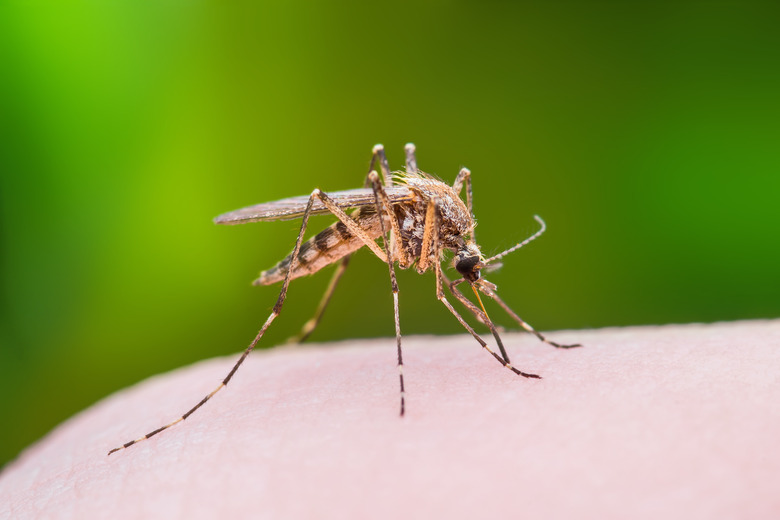Difference Between Mosquito & Sand Fly Bites
Sand flies and mosquitoes are non-venomous insects that bite to obtain blood protein. In most cases their bites are harmless, but sometimes mosquitoes and sand flies carry and spread disease. While both bites produce an itchy welt, there are a few distinct differences between mosquito and sand fly bites. In either case, you can protect yourself from being bitten by wearing insect repellent and reducing the amount of skin you expose at the times of day when bites are most prevalent.
TL;DR (Too Long; Didn't Read)
Both sand flies and mosquitos bite many kinds of animals to obtain blood protein, and both leave skin reactions behind. In both species, only the females bite to feed on blood; the males feed on plant products. The insects leave saliva under the skin as they feed. The saliva briefly thins the blood and prevents it from clotting so that it is easier to feed on. Humans' have immune responses to the saliva that is left behind, which is what causes the swelling, itching, redness and pain. People's reactions to mosquito and sand flies' bites vary depending on their immune responses.
Mosquitoes are attracted to people by things like carbon dioxide exhalation, perspiration, scented deodorants and soaps, movement and body heat. They typically bite in the evening and nighttime. Sand flies typically bite at dawn and dusk, and they are known to attack people in swarms. They prefer to bite the face, hands and scalp. Mosquito bites become a raised, red, itching bump, while sand fly bites are very small and painful and appear in clusters. They can cause rashes and fevers. Mosquitos can transmit malaria and yellow fever, while sand flies can transmit diseases such as Carrion's disease, pappataci fever, filarial worms and conditions like leishmaniasis.
Vampire-Like Insects
Vampire-Like Insects
Mosquitoes and sand flies bite their prey to feed on their blood. In both insects, only the females bite in order to gain blood protein so they are able to produce eggs. A bite from a mosquito or sand fly turns into an itchy welt because the female injects saliva into the victim as it feeds. The saliva works to thin the blood and prevent it from clotting during the feeding. This saliva causes an immune reaction that causes the bite to itch and swell.
Attracting Mosquito Bites
Attracting Mosquito Bites
There are well over 2,000 species of mosquitoes worldwide. These flying insects feed on the blood of both birds and mammals. Many factors attract and cause mosquitoes to bite humans, including exhaled carbon dioxide, moisture, lactic acid and perspiration. Mosquitoes are also attracted by things like deodorants, detergents, movement and body heat. People wearing dark colors are more likely to be bitten, because dark colors absorb more heat. Mosquitoes commonly bite in the evening and nighttime; however these bugs can bite at any time of day.
Sand Flies’ Attack Strategies
Sand Flies' Attack Strategies
Sand flies are also called biting midges. These insects live in and around aquatic and semi-aquatic habitats, including mud and wet organic debris. During windy weather they remain inactive. Typically, female sand flies emerge to find victims in the early morning hours and at dusk. Like mosquitos, sand flies also feed on a wide variety of animals, including humans. Unlike mosquitos, sand flies are known to attack humans in large numbers. They commonly bite the face, hands or scalp of their victims, but they will also bite any area of exposed skin.
Itching, Painful Bites
Itching, Painful Bites
Both sand flies and mosquitoes produce a red, itchy bump after biting humans, although people are often not aware of either kind of bite until a few hours later. Some people will experience more intense allergic reactions than others. A mosquito bite may also produce a burning sensation and turn into a large welt. Sand fly bites typically occur in clusters. Their bites are very painful. A bite from a small sand fly can be more painful that the bite of a large mosquito. Sand fly bites can also produces rashes and cause fevers in their victims depending on the tolerance to the bite.
Contagious Diseases
Contagious Diseases
While most bites from a mosquito or sand fly are simply an itchy annoyance, these bugs are known in some areas to transmit diseases. Mosquitoes can transmit malaria and yellow fever through their bites. Sand flies can transmit ailments like Carrion's disease, pappataci fever, filarial worms and conditions like leishmaniasis, which is likened to malaria
Cite This Article
MLA
Maier, Casandra. "Difference Between Mosquito & Sand Fly Bites" sciencing.com, https://www.sciencing.com/difference-between-mosquito-sand-fly-bites-11368299/. 25 April 2018.
APA
Maier, Casandra. (2018, April 25). Difference Between Mosquito & Sand Fly Bites. sciencing.com. Retrieved from https://www.sciencing.com/difference-between-mosquito-sand-fly-bites-11368299/
Chicago
Maier, Casandra. Difference Between Mosquito & Sand Fly Bites last modified March 24, 2022. https://www.sciencing.com/difference-between-mosquito-sand-fly-bites-11368299/
